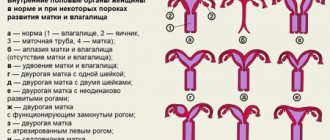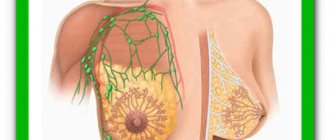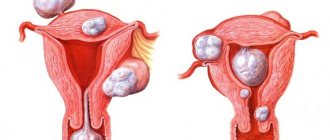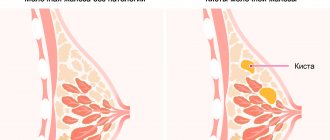One of the most common benign formations in the breast is breast fibroadenoma, which is also a form of mastopathy and occurs in most cases due to an imbalance of female sex hormones. This disease is most often observed in childbearing women, so breast fibroadenoma and pregnancy often become an adjacent combination.
Description
Fibroadenoma is a round and dense neoplasm in the breast that is mobile. The tumor predominantly develops in one breast, consists of overdeveloped connective tissue of the mammary gland and is penetrated by fibrous fibers. Its size does not affect the possibility of developing into a cancerous formation; it can be from 0.2 mm to 7.5 cm. Symptoms occur unnoticed, there is no pain, skin changes, swelling or discharge from the nipple. A woman can only feel the lump in her breast, which easily moves from place to place. Predisposing factors for the appearance of such a tumor include:
- heavy loads of psychological and physical nature;
- depression and stress;
- hormonal changes;
- pregnancy;
- endocrine diseases.
Based on the type of structure, fibroadenomas are distinguished: intracanalicular, pericanalicular, leaf-shaped and mixed. There are also mature and immature formations, where in the first case the fibroadenoma has a capsule and develops slowly, and in the second case the capsule is soft and the neoplasm is prone to active growth.
Development of fibroadenoma during pregnancy
Fibroadenoma during pregnancy is not the most common, but still occurs. And for a woman facing this problem, it is important to find out all the possible risks and find out how to minimize them.
Can fibroadenoma appear during pregnancy?
Fibroadenoma is a benign neoplasm localized in the mammary gland, suggesting a predominance of connective components, but at the same time having a glandular origin. This tumor most often occurs in women, and young women at that. The peak occurs during childbearing age - the period from 20 to 30-35 years.
As a rule, fibroadenomas are discovered directly by women themselves during self-examinations. They can also be diagnosed completely by accident during a routine examination. The tumor is a kind of easily palpable neoplasm. It has an elastic-dense consistency and marked boundaries, and also moves in the tissues of the gland.
Upon palpation, you can detect a small lump that will move easily. Dimensions can range from a few millimeters or 1 cm to 5-7 centimeters or more. The disease can be almost asymptomatic and not cause any discomfort to the woman. But if the fibroadenoma begins to grow quickly, then it can change the shape and size of the breast and even cause discomfort or pain.
Reasons for appearance
The exact reasons for the appearance are unknown, but hormonal changes play a certain role in development, since the mammary glands are considered hormone-dependent organs. Provoking negative factors include:
- soft tissue injuries of the chest
- frequent and severe stress
- increased emotional or physical stress
- concomitant endocrine or gynecological diseases or disorders
- frequent insolation (sunbathing) and thermal effects
It is logical that pregnancy can trigger the development of fibroadenoma, because this stage is associated with serious hormonal changes that have a direct impact on the structure of the mammary glands. But in fact, looking at the statistics, one can come to the conclusion that the pregnancy period itself is incorrect to consider as the cause of the occurrence of a neoplasm. In most cases, benign tumors are detected even before its onset. If fibroadenoma is diagnosed after conception, this does not mean that fertilization was the trigger. Most likely, the tumor was present in the mammary gland before.
Note! User recommendation! For the treatment and prevention of breast diseases, our readers successfully use an effective remedy to combat these ailments. Cedar resin will improve blood circulation, relieve swelling, and bee venom will relieve pain. Get rid of pain..."
How pregnancy affects the development of the disease
Can fibroadenoma increase in size during pregnancy or, on the contrary, decrease? It is impossible to predict the exact scenario for the development of the disease, since it depends on many factors, such as the type of tumor, its structure and size, concomitant diseases, and so on. And although the tumor does not have a negative effect on the course of pregnancy, its size and structure under the influence of hormones can change, and not for the better.
Since significant hormonal changes occur during gestation, the fibroadenoma of your mammary gland may change during pregnancy, either growing or shrinking or slightly changing its structure. Often, an increase in the level of female hormones, which provokes cell proliferation, causes tumor growth. And it is especially often observed if the size is more than 3 cm. If the fibroadenoma has a small diameter (1 centimeter or less), then, most likely, a noticeable increase will not be observed.
Anamnesis is also taken into account, that is, the characteristics of the course of the disease before pregnancy. If before conception the tumor grew at a rapid pace, then, unfortunately, it can continue to grow after fertilization. If the growth was insignificant or absent, then there is a high probability that the diameter will remain the same during pregnancy, and it does not matter what it was previously: 1 cm or 3-4. Interesting: phyllodes or leaf-shaped fibroadenomas are considered the most dangerous. They are prone to rapid growth, and hormones produced during pregnancy can accelerate this.
Planning a pregnancy
In order for pregnancy to proceed without complications, it must be planned, especially if a woman is diagnosed with fibroadenoma, even if it is less than 1 cm in size. Moreover, it is not enough just to know about the tumor; it is extremely important to minimize or completely eliminate all risks. But even an experienced doctor cannot evaluate them, because it is unknown how the female body will behave after conception. And therefore, almost all women who have fibroadenomas and are planning pregnancy are recommended to remove the tumor. Removal is also recommended and even mandatory before IVF, because the protocol includes stimulation of ovulation, and this involves taking hormonal drugs and therefore can lead to serious consequences, provoking the growth of a tumor.
After removal of the tumor, you should not begin making active attempts to conceive, since the woman’s body will need time to recover from the surgery. Rehabilitation can last one to three months or six months, and at this stage it is important to regularly visit a mammologist to monitor the dynamics and notice problems in time. If the fibroadenoma has not reappeared and the structure of the mammary glands has been completely restored, then you can begin planning a pregnancy.
If fibroadenoma was diagnosed by chance already during pregnancy, and its growth is observed, then surgery can be performed at this stage. But usually such surgical procedures are carried out in the second trimester of pregnancy (at least three months after fertilization), since in the first trimester all the organs of the unborn child are formed, and any interventions can affect this important process.
Fibroadenoma and lactation
Lactation in most cases has a beneficial effect on fibroadenomas and in some cases slows or stops growth or even causes degeneration, that is, destruction. This is due to the fact that during breastfeeding prolactin is released in increased quantities, and it slows down the production of other hormones that provoke the growth of fibroadenoma. And therefore, women with such neoplasms are not recommended to end lactation too early or abruptly. It is advisable to continue it for a year or longer.
If you are reading these lines, we can conclude that all your attempts to combat chest pain have not been successful... Have you even read anything about medications designed to defeat the infection? And this is not surprising, because mastopathy can be fatal to humans - it can develop very quickly.
- Frequent chest pain
- Discomfort
- Experiences
- Discharge
- Skin changes
Surely you know these symptoms firsthand.
But is it possible to defeat the infection without harming yourself? Read the article about effective, modern ways to effectively combat mastopathy and more... Read the article... Important: if fibroadenoma blocks the milk ducts, this can cause lactostasis or mastitis. Fibroadenoma diagnosed during or before pregnancy is not a reason to panic. But such a neoplasm requires constant monitoring and compliance with certain rules.
bolivgrudi.ru
Planning a pregnancy
If a young girl planning to become pregnant in the near future is diagnosed with a fibroadenoma, doctors usually recommend removing the tumor first. Pregnancy is different in that during its course various hormonal changes occur in the female body, which can cause active growth of a breast tumor. In addition, hormonal changes can provoke the development of a benign tumor into a malignant tumor. This is especially true for the presence of a fast-growing nodular fibroadenoma or a leaf-shaped tumor.
With subsequent natural feeding of the child, there is a risk of fibroadenoma blocking the milk ducts, which can lead to lactostasis and then mastitis. Intracanalicular fibroadenoma, growing inside the milk duct, and pericanalicular fibroadenoma, growing around the milk ducts and compressing them, create a direct threat to milk stagnation.
After the operation, the woman is recommended to avoid stressful situations, restore the health of the body and follow the correct daily routine so that the subsequent pregnancy proceeds calmly and easily.
Kinds
In medical practice, it is customary to distinguish the following types of fibroadenoma of the mammary glands:
- Intracanalicular form. This type of benign neoplasm occurs through the proliferation of interductal connective tissue. A characteristic feature of intracanalicular fibroadenoma is the presence of separate lobes with a loose structure and moderately defined boundaries;
- Perikanalicular form. This benign neoplasm is formed by the proliferation of fibrous tissue, which is located around the milk duct. The tumor is characterized by a homogeneous structure;
- Leaf-shaped. The rapid growth of such a tumor can lead to its rapid increase to a size of 30-40 cm in diameter. When exposed to unfavorable factors, leaf-shaped fibroadenoma tends to degenerate into a malignant tumor.
Under certain circumstances, a woman develops a benign breast tumor, which combines pericanalicular and intracanalicular fibroadenoma. This neoplasm does not have a tendency to malignant degeneration.
Pregnancy
Pregnancy and fibroadenoma can sometimes be detected at the same time, in which case treatment of the disease will depend on the doctor’s decision, since this is a rather dangerous and unpredictable situation. During the period of gestation and breastfeeding, the development of fibroadenoma cannot be predicted with probable accuracy, since intense stimulation of the connective tissue occurs and the mammary gland increases in size. In a quarter of cases, pregnancy becomes a provocateur of the active growth of fibroadenoma, since at this time physiologically determined proliferation of parenchyma cells occurs.
But sometimes it happens that breast fibroadenoma, consisting of small immature nodules, can degenerate on its own. In turn, fibroadenoma in no way affects pregnancy or the development of the fetus, but the health of the woman herself will always be threatened by the unpredictable behavior of the tumor.
Removing a tumor from a pregnant woman is a rare occurrence, as it may be unsafe for the mother and child. But there are extreme cases when surgery is performed under local anesthesia for periods longer than 3 months. If the fibroadenoma was not removed during pregnancy, then often after childbirth its size can decrease under the influence of progesterone.
Fibroadenoma and IVF: how compatible are they?
The presence of this form of fibrocystic mastopathy in the breast does not in any way prevent in vitro fertilization (IVF), however, doctors, caring for their patients, insist on removing any tumors before IVF is performed.
We know that the procedure is quite expensive (just read the reviews), so it’s not worth taking unnecessary risks and it’s better to immediately carefully prepare for the operation before getting pregnant. It is important to understand that before IVF the body undergoes serious preparation, which increases the stimulation of the ovaries and, as a result, the amount of the hormone estrogen. And it, in turn, provokes the activity of absolutely any tumor. Therefore, we advise expectant mothers not to take risks and get rid of unnecessary tumors in advance in order to get the desired result.
Lactation
Due to the fact that during the lactation period a woman does not have surges of estrogen, the menstrual cycle stops. The production of the pituitary hormone prolactin inhibits the production of estrogen, which has a very positive effect on stopping the development of fibroadenoma. Long-term breastfeeding will be the best solution to the problem of breast fibroadenoma. However, the woman will have to be observed by a mammologist every three months during breastfeeding.
After stopping feeding, drug therapy or surgery to remove the fibroadenoma can be performed.
Breast fibroadenoma and pregnancy
A woman’s breast is a multifunctional organ that is responsible not only for its aesthetic appearance, but also for the complete feeding of a newborn baby. Unfortunately, the mammary glands are very sensitive to the negative effects of external factors and internal problems in the body. That is why breast diseases are first on the list in terms of their number and number among women of all age groups. Most often, young nulliparous girls and girls planning pregnancy under the age of 30 experience the so-called fibroadenoma of the mammary gland.
Fibroadenoma is a benign formation that has a spherical shape and a dense consistency. In this case, the patients do not observe other clinical manifestations, except for palpation of the elastic and movable node. The unambiguous reasons preceding the appearance of a tumor are not fully understood. However, it has been established that fibroadenoma is dependent on the woman’s hormonal background, and in particular on the level of estrogen. This explains the appearance of compactions just during periods of hormonal changes, one of which is pregnancy.
Fibroadenoma during pregnancy
Regardless of when fibroadenoma appeared: during pregnancy or before it, there are two options for the development of events. Moreover, both of them are scientifically substantiated and have a lot of examples in practice.
In the first case, urgent removal of the fibroadenoma is assumed, since, according to some experts, this phenomenon and pregnancy are incompatible. By how hormonal changes associated with the restructuring of the body and its preparation for bearing and giving birth to a child can provoke active tumor growth. This is especially true for compactions that exceed 1 cm in size and mature formations with a dense capsule that do not have the ability to dissolve.
There is also an opposite opinion, whose supporters suggest that the presence of breast fibroadenoma during pregnancy, during its normal course, cannot have negative consequences. On the contrary, subsequent long-term breastfeeding, with the appropriate hormonal background, has the best effect on the compaction and promotes its resorption. The chances of the tumor disappearing on its own increase significantly if the tumor is immature and the woman continues to breastfeed for 1.5-2 years.
Fibroadenoma does not affect the condition and development of the fetus.
Related articles:
| TORCH infections during pregnancy Unfortunately, most infections included in the TORCH complex are detected in women only during pregnancy, which is fraught with all sorts of complications and unpleasant consequences. What effect can these diseases have on the fetus? | What does torch complex mean? Not every woman can answer this question, although most people who have given birth have come across this term. Let's figure out what it is and why it is important for all pregnant women to know about it. |
| Rotavirus infection during pregnancy Rotavirus infection, which almost everyone has had, can be a dangerous disease during pregnancy. Therefore, every woman should know the signs of rotavirus so as not to confuse them with toxicosis. | Expectant mothers should listen very carefully to their bodies and pay attention to alarming symptoms. Let us tell you in more detail why pregnant women experience chills and whether this condition is dangerous. |
womanadvice.ru
Pregnancy and cancer
Diagnosis of malignant breast formation is a common occurrence in pregnant women. This occurs due to hormonal changes in the body that provoke the development of cancer cells. However, if a tumor is detected early, there is a great chance for a positive outcome for both mother and fetus. But diagnosing a cancerous tumor in the breast is quite difficult, since during pregnancy the breasts swell and increase in size. The first signs of the disease are the appearance of painful lumps and disproportionate enlargement of the mammary glands.
Malignant cells cannot affect the child’s health and do not pose a threat to him. And for treatment, mothers usually use the most harmless methods so as not to have a strong negative impact on the woman’s immune system. After giving birth, the woman will face serious treatment through chemotherapy or surgical removal of the tumor.
What symptoms does it present?
A node appears in the mammary gland, usually round, with clear, even edges, painless, elastic. It is not fused to the skin and moves easily. There may be one or more fibroadenomas in the mammary gland. Sometimes they are so small that they cannot be felt; such nodes are detected only with the help of ultrasound. The size of the nodes can reach 8 cm or more. If you find a lump in your breast that was not there before, you need to visit a mammologist and undergo an examination. This will help rule out a malignant tumor.
Can fibroadenoma be dangerous? Usually the neoplasm does not pose any danger; it almost never transforms into cancer. But if the neoplasm has a complex structure, contains cysts and areas of calcification (calcifications), the risk of cancer increases.
Folk remedies
Many pregnant women with breast fibroadenoma use folk remedies, which is not the right solution. It is important to first consult with a gynecologist or mammologist, who can prescribe safe treatment at home. One of the popular recipes for treating fibroadenoma is to take dried chamomile flowers and marshmallow root, poured with boiling water and infused. The infusion is consumed 3-4 times a day.
Pregnancy is an exceptional period in the life of any woman, but it requires careful attention and monitoring of the changes occurring in the body. Female mammary glands are especially sensitive to hormonal changes and must be examined regularly. The detection of breast fibroadenoma during this period should serve as a sign for the woman to look at her regimen, psychological and physical state from the other side and try to change everything in a more positive and correct direction.
removal of fibroadenoma during pregnancy
Diseases of the mammary glands - mastopathy, cysts, fibroadenoma of the mammary gland, as well as uterine fibroids, ovarian cysts, endometriosis (adenomyosis), endometrial hyperplasia, adnexitis, polycystic ovaries - this is not a complete list of female diseases that are successfully treated in our clinic.
We talk about the cause of these diseases, as well as about a new effective treatment method, with Elena SINITSYNA, an endocrinologist of the highest category. — Dear Elena Nikolaevna, what is our guilt as women before the Creator that he sent us so many “sores”? - This is explained by the fact that the female body, firstly, is more complex than the male one, and secondly, I would say, much more refined. — Constantly hearing about the advantages of the male mind, it’s nice to realize that we are more complex than they are. What is this directly expressed in? - God gave men one main sex hormone - testosterone. The higher its level and the adequate emissions, the more active and persistent the continuer of the human race behaves in relation to the fair sex. And God gave women two main sex hormones, which are antagonists and, depending on the cycle, replace each other approximately every two weeks. - Do you mean the menstrual cycle? To my shame, I still don’t know its exact purpose, except that on certain days the likelihood of getting pregnant increases sharply... - If only you! A large number of women with infertility or simply wanting to become mothers come to see me; they use various terms, but still do not understand the meaning of the processes taking place in the female body. But menstrual irregularities are the first sign that not everything is going well in the body! - Well, tell us all about it. - Let's figure it out together: what happens during the cycle? In its first half, sex hormones - estrogens - are active. The range of their influence on the female body is multifaceted: from the condition of the skin and nails to mood. But most importantly, estrogens stimulate the division of germ cells and promote their reproduction. At this moment, endometrial cells (the inner lining of the uterus) begin to actively grow. Thus, the inner shell prepares to receive and, in the event of fertilization, hold the egg and prevent it from slipping out. An insufficiently developed endometrium cannot cope with this task. It is believed that 2-3% of women lose an already fertilized egg for this very reason, without even suspecting that they were pregnant! Adenomyosis (internal endometriosis) is a situation when the endometrium becomes loose, and the embryo in this place will also not be able to gain a foothold.
Endometrium under attack Classic treatment of endometrial hyperplasia, adenomyosis (endometriosis) is the elimination of hyperestrogenemia (increased estrogen content). Scientists have long established that the endometrium is a target for the action of estrogen. However, the body also has control organs - the neuroendocrine system, which also controls the production of estrogen. If you influence this system, then the treatment of endometriosis, adenomyosis, and endometrial hyperplasia will be incomparably more effective. When all the conditions are created so that the egg can firmly attach itself, ovulation occurs - the follicle ruptures, and a mature egg, ready for fertilization, breaks out. - What if this doesn’t happen? — If it doesn’t happen, a diagnosis of polycystic ovary syndrome will be made. The entire process of follicle formation and rupture is easily recorded by ultrasound. How to break the “vicious circle” Ovarian cyst, if it is not a congenital pathology, is a hormone-dependent disease; menstrual irregularities play a big role in its occurrence. Often the ovarian cyst itself can secrete estrogens, creating an excess of them in the body, and as a result, more and more new problems. This means that a vicious circle arises, which can only be broken by identifying the cause of the disease. Therefore, treatment of ovarian cysts is not limited to the prescription of hormonal drugs. This is, first of all, the treatment of those diseases that caused hormonal imbalance. If the cause is eliminated, then treating an ovarian cyst is not particularly difficult. Treatment of polycystic ovary syndrome also means normalizing hormonal levels and eliminating all the causes that caused its disruption.
- Let's return to the egg... - At the moment when the egg is released, the female body is maximally interested in fertilization, and this strongly influences the woman’s behavior on a subconscious level. Ovulation lasts a very short period. If fertilization does not occur, the level of estrogen drops, and the amount of progesterone, the second main sex hormone in women, increases. In the second half of the cycle, it promotes the natural death of all cells produced under the influence of estrogen. Now let's summarize: in the female body, billions of cells are regularly produced, destroyed, and then removed during each cycle. And this happens from about 13 to 50 years for every woman. Think about these numbers! - Impressive! And we “endure” all this only so that at some point we can get pregnant and give birth to a healthy child? - You're right. But besides this, we must not forget that a woman’s behavior, her mood and actions are constantly in direct proportion to the amount of hormones and their ratio. Men, I'm sure, don't understand this. — What if, for some reason, a malfunction of the endocrine glands occurs in our body? - That’s when breast fibroadenoma and uterine fibroids form
, mastopathy, ovarian cyst, endometrial hyperplasia or endometriosis (adenomyosis). Because during the menstrual cycle, the number of cells formed and removed should ideally match. And this happens as long as the balance of our two main hormones - estrogen and progesterone - is normal. Menstrual irregularity is a situation when the number of cells formed exceeds the number destroyed. Their number will begin to increase from cycle to cycle. And the body’s self-regulatory system will be faced with a question. Where should I put them?
- And where?
- But there are only three options: either into the uterus - and then uterine fibroids form; or into the mammary gland - mastopathy, mammary fibroadenoma or cyst occurs. Either the endometrial cells themselves grow - then endometrial hyperplasia is diagnosed or endometriosis develops (adenomyosis ). — For what reason can the estrogen-progesterone balance be disturbed? — The main reason is stress, which has an extremely negative effect on the functioning of the thyroid gland, adrenal glands and ovaries. In our clinic, the condition of the thyroid gland is thoroughly and comprehensively examined, and if abnormalities are detected, adequate treatment is provided. According to statistics, women suffer from thyroid disorders 4 times more often than men. And it’s not just the hormonal changes that occur during pregnancy, abortion, and childbirth that are “to blame” for this. Each woman has her own reason, which must be methodically identified. Our studies of the female body have discovered another interesting pattern: the left lobe of the thyroid gland affects the condition of the left mammary gland, and the right lobe affects the condition of the right mammary gland. The same dependence of the condition of the mammary glands exists on the ovaries. For example, inflammation of the left ovary - adnexitis - will immediately affect the left mammary gland, causing lumps and pain, and mastopathy is often detected. That is why in our diagnostic program “Women’s Health” we pay great attention to the infectious component. Treatment of adnexitis and other chronic inflammatory processes must be carried out quickly and without complications, which is what we do. Interesting fact Treatment of mastopathy can be effective... after normalizing the function of the liver and pancreas. This seemingly paradoxical fact has a scientific explanation. The mammary gland is closely connected with all organs of the endocrine system, and sometimes any trouble on the part of organs not directly related to the female genital area can provoke mastopathy. Treatment of mastopathy is an art, including systemic diagnostics! — I have a friend who was operated on twice for a breast cyst. She is awaiting her third operation. So, surgery does not guarantee recovery? - Of course no. After all, as we said earlier, the root cause of the disease is not eliminated - a violation of the estrogen-progesterone balance. Only an integrated approach to the body can help in such cases. We recently “resolved” a fibroadenoma measuring about 2 cm from an English woman who came to us for treatment. — What is the effectiveness of your therapeutic treatment method? — Treatment of endometriosis, polycystic ovary syndrome and other diseases consists of three parts. This is carrying out, if necessary, anti-inflammatory therapy of the ovaries (treatment of adnexitis) and other organs with foci of inflammation, so that the immune system is the absolute master of the situation in the body. These are unique physiotherapeutic systems that allow you to directly influence atypical, unnecessary cells in order to remove them from the body. And finally, this is the normalization of the functioning of the neuroendocrine system: the tone of the blood vessels in the brain, the function of the thyroid gland and adrenal glands, which secrete female sex hormones. Thus, we eliminate the very cause of diseases. By normalizing the estrogen-progesterone balance, we will get a stable result. It is important that women understand this.











